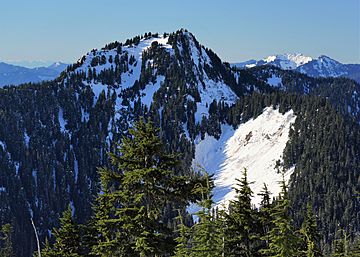Lookout Mountain (Washington) facts for kids
Quick facts for kids Lookout Mountain |
|
|---|---|

Lookout Mountain, east aspect
|
|
| Highest point | |
| Elevation | 5,699 ft (1,737 m) |
| Prominence | 1,139 ft (347 m) |
| Isolation | 3.17 mi (5.10 km) |
| Parent peak | Little Devil Peak |
| Geography | |
| Location | Skagit County, Washington, U.S. |
| Parent range | Cascade Range |
| Topo map | USGS Big Devil Peak |
| Climbing | |
| Easiest route | Hiking trail |
Lookout Mountain is a tall mountain peak in the North Cascades area of Washington state. It stands at 5,699-foot (1,737 m) (about 1.7 kilometers) high. You can find it in Skagit County, about five miles east of the town of Marblemount. This mountain is part of the Mount Baker-Snoqualmie National Forest.
At the very top of Lookout Mountain, there's a special building called a lookout station. It was built in 1962 to help spot forest fires, replacing an older one from 1929. From the top, you can see amazing views! To the west, you might spot Sauk Mountain. Looking east and north, you can see Eldorado Peak and the rugged Picket Range inside North Cascades National Park. Lookout Mountain is actually very close to the park, just one mile outside its border. You can reach the top by hiking a 4.7-mile trail that climbs over 4,400 feet. All the water that runs off Lookout Mountain eventually flows into the Skagit River.
Contents
Mountain Weather: Climate of Lookout Mountain
Lookout Mountain is in a place with a "marine west coast" climate. This means it gets a lot of influence from the nearby Pacific Ocean. Most of the weather systems, like big clouds and storms, start over the Pacific. They then travel northeast towards the Cascade Mountains.
How Mountains Affect Weather
When these weather systems hit the tall North Cascades mountains, they are forced to rise. As the air goes higher, it cools down and drops its moisture. This process is called orographic lift. Because of this, the western side of the North Cascades gets a lot of rain and snowfall, especially in winter.
Seasonal Weather Patterns
Thanks to the ocean's influence, the temperatures here are usually mild. It rarely gets colder than 0 °F (−18 °C) or hotter than 80 °F (27 °C). In winter, it's often cloudy. But in summer, high-pressure systems over the Pacific Ocean usually bring clear skies and lots of sunshine. Because the snow is often wet and heavy due to the ocean's influence, there can be a danger of avalanches.
Mountain Building: Geology of the North Cascades
The North Cascades mountains are known for their very rugged and dramatic shapes. They have sharp peaks, long ridges, and deep valleys carved out by glaciers. The amazing look of these mountains, with their huge changes in height, was created by geological events that happened millions of years ago. These events also led to different climates and types of plants in various areas.
How the Mountains Formed
The story of the Cascade Mountains began millions of years ago, during a time called the Eocene Epoch. Back then, the North American Plate (a huge piece of Earth's crust) was slowly moving over the Pacific Plate. This movement caused a lot of volcanic activity. Also, smaller pieces of Earth's crust, called terranes, crashed into the North American continent. These collisions helped build up the North Cascades about 50 million years ago.
Ice and Earthquakes: Shaping the Landscape
Over the last two million years, during the Pleistocene period, huge sheets of ice called glaciers repeatedly moved across the land. As they advanced and then melted back, they scraped and shaped the landscape. This left behind piles of rock and debris. The "U"-shaped valleys you see in the mountains today were carved out by these powerful glaciers. The combination of the land being pushed up (called uplift) and cracks forming in the Earth's crust (called faulting), along with the glaciers, created the tall peaks and deep valleys of the North Cascades.
Images for kids




